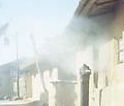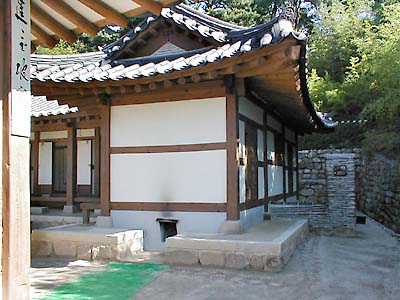|
Your first winter in Korea, you're apt to discover one of Korea's greatest inventions:
the heated floor they call ondol.
The word ondol means "warm stone." Historians think it may have
been invented in the 4th century, possibly even as far back as 5000BC.
If you visit one of Korea's historical villages or houses today, you'll probably get to see
an original ondol. The floor in a traditional setup, also called gudul, is usually made of
granite blocks, about 5 cm thick, supported by columns of brick or stone. The flue from a fireplace
or kitchen stove is run between those supports, and that's what provides the heat. Believe it or not,
this is essentially the same principle that modern high efficiency gas and oil furnaces and boilers
use -- recovering heat from the flue gases. And Korea discovered it at least 1,700 years ago.
On top of the granite blocks is a concrete (originally clay) surface for smoothness and comfort
under your ondol (futon) mattress. This was topped with oiled paper in the old days, but today
it's usually vinyl.
A typical Korean house in the Choson Dynasty consisted of two rooms plus a kitchen. The flue from
the kitchen stove ran under the floors of the other rooms to give them heat.
Many houses also had extra fireplaces for still more room heat. That's what you see in the photo above.
It's a building at
Ojukon
(Ojukheon in the new official Romanization), the Kangnung (Gangneung) home of Choson Dynasty statesman
Yi Yul Guk (Yi I). The dark rectangular hole at ground level, just to the left of lower center in the photo,
is the heating fireplace -- you can see the soot streak above it. The freestanding masonry chimney for
it is on the right side of the picture, so the flue takes a right turn under the house.

|
| Kitchen at Ojukon (Sept 2000). |
|
What surprises me
is that the chimney is lower than the roofline. I've noticed this about every ondol chimney I've seen so far.
It seems awfully low for a good draught, but I have to assume that the builders knew what they were doing.
I'm sure ondols did a great job of keeping the house warm, but you have to feel sorry for the poor house servant
who had to slog out there on frigid February nights to stoke the heating fireplace while the owners stayed snug
inside.
In the photo at left, we're in the kitchen of Ojukon (click the photo to see it in more detail). The kitchen
has two ondol fireplaces for cooking. Again the flue runs under part of the rest of the house so as not to
waste the stack heat.
At right (click pic for larger version) is a closeup shot of an ondol fireplace at
Songyojong
(The House of 100 Rooms). To get this photo I had to duck into the access port that leads below ground level
and right up to the fireplace's open face. I'm right down on the ground with the camera, just about under the
house. You can see that this foundation has been rebuilt with modern materials -- the house might have
fallen down otherwise.
Check out the stacks of firewood on both sides of the picture, too.
Firewood like that is something of a rarity in Korea, which is one reason almost nobody actually uses traditional
ondols any more. (The other reason is that modern ondol heating is way more comfortable and convenient.) Between
the Japanese occupation and the Korean War, South Korea was pretty well stripped of its timber, and the government
has been trying to reforest ever since.
 |
| Wood ondol, Hahoe, Oct 2000. |
|
It's only been in recent years that
they've allowed anyone to cut firewood at all.
So no worries, you won't have to bundle up and trudge out into the snowy cold to fire up your Korean apartment's
heat next winter. Your place will have pipes in the floors, and a gas or oil boiler to circulate hot water through
them. This setup is at least as cozy as a traditional ondol, but without the wood and the work. It's more efficient
and cleaner, too. Your floor will have a vinyl covering, since carpet would interfere with the heat.
Today about the only place you'll still see a real live wood-fired ondol is use is in a historical recreation.
Margaret shot the clickable photo at left in
Hahoe Folk Village
in October of 2000.
|

